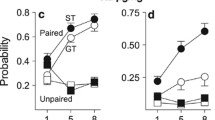Abstract
Olfactory cues from prior subjects in operant chambers were shown to be an effective stimulus which rodents could use to direct lever selection in a typical operant drug discrimination (DD) paradigm. Such cues persisted for very long periods of time (16h), and were deposited after very short (5 min) operant sessions. In extinction tests inter-animal olfactory cues exerted very strong stimulus control over lever selection. Furthermore, such cues were not specific to individual rodent subjects but were generalizable between subjects. Inter-animal cues directing lever selection could be abolished by cleaning operant manipulanda with a 10% alcohol solution. Reanalysis of some DD data previously reported by one of the authors (Goudie 1977) indicated that this specific earlier study (and by implication perhaps other studies) might have been confounded by inter-animal cues. In a DD study with nicotine it was found that the drug cue was antagonized by mecamylamine for all subjects except those who had a reliable olfactory cue from prior subjects to direct lever selection (subjects who possessed both an olfactory and a drug cue to direct lever selection responded in a way suggesting that the exteroceptive olfactory cue controlled behaviour rather than the interoceptive drug cue). These findings indicate that inter-animal olfactory cues could be of considerable methodological significance in DD studies. The possible significance of such cues has not previously been reported upon in detail, and in reports of many DD studies there do not appear to be explicit indications that interanimal cues have been adequately controlled.
Similar content being viewed by others
References
Barry H III (1974) Classification of drugs according to their discriminable effects in rats. Fed Proc 33:1814–1824
Chance WT, Murfin D, Krynock G, Rosecrans JA (1977) A description of the nicotine stimulus and tests of its generalization to amphetamine. Psychopharmacology 55:19–26
Colpaert FC (1978) Some properties of drugs as physiological signals: The FR procedure and signal detection theory. In: Colpaert FC, Rosecrans JA (eds) Stimulus properties of drugs: Ten years of progress. Elsevier/North Holland Biomedical Press, Amsterdam
Colpaert FC, Niemegeers CJE, Janssen PAJ (1976) Theoretical and methodological considerations on drug discrimination learning. Psychopharmacologia 49:169–177
Colpaert FC, Niemegeers CJE, Jansen PAJ (1977) Differential haloperidol effect on two indices of fentanyl-saline discrimination. Psychopharmacology 53:169–173
Colpaert FC, Niemegeers CJE, Janssen PAJ (1980a) Factors regulating drug cue sensitivity: The effect of training dose in fentanyl-saline discrimination. Neuropharmacology 19:705–713
Colpaert FC, Niemegeers CJE, Janssen PAJ (1980b) Factors regulating drug cue sensitivity: Limits of discriminability and the role of progressively decreasing training dose in fentanyl-saline discrimination. J Pharmacol Exp Therap 212:474–480
Colpaert FC, Rosecrans JA (eds) (1978) Stimulus properties of drugs: Ten years of progress. Elsevier/North Holland Biomedical Press, Amsterdam
D'Mello GD, Stolerman IP (1978) Methodological issues in drug-discrimination learning. In: Colpaert FC, Rosecrans JA (eds) Stimulus properties of drugs: Ten years of progress. Elsevier/North Holland Biomedical Press, Amsterdam
Goudie AJ (1977) Discriminative stimulus properties of fenfluramine in an operant task: An analysis of its cue function. Psychopharmacology 53:97–102
Ho BT, Richards DW, Chute DL (eds) (1978) Drug discrimination and state dependent learning. Academic Press, New York
Jennings JW, Keefer JH (1969) Olfactory learning set in two varieties of domestic rat. Psych Rep 24:3–15
Lal H (ed) (1977) Discriminative stimulus properties of drugs. Plenum Press, New York
Lavin MJ, Freise B, Coombes S (1980) Transferred flavor aversions in adult rats. Behav Neurol Biol 28:15–33
Ludvigson HW, Systma D (1967) The sweet smell of success: Apparent double alternation in the rat. Psychonom Sci 9:283–284
Means LW, Hardy WT, Gabriel M, Uphold JD (1971) Utilization of odor trails by rats in maze learning. J Comp Physiol Psychol 76:161–164
Nigrosh BJ, Slotnick BM, Nevin JA (1975) Olfactory discrimination, reversal learning and stimulus control in rats. J Comp Physiol Psychol 89:285–294
Olton DS, Collison C (1979) Intramaze cues and “odor trails” fail to direct choice behavior on an elevated maze. Anim Learn Behav 7:221–223
Overton DA (1978) Influence of training compartment design on performance in the two-bar drug discrimination task: A methodological report. In: Colpaert FC, Rosecrans JA (eds) Stimulus properties of drugs: Ten years of progress. Elsevier/North Holland Biomedical Press, Amsterdam
Overton DA (1979a) Drug discrimination with progressively lowered drug doses. Science 205:720–721
Overton DA (1979b) Influence of shaping procdures and schedules of reinforcement on performance in the two-bar drug discrimination task: A methodological report. Psychopharmacology 65:291–298
Rosecrans JA, Glennon RA (1979) Drug-induced cues in studying mechanisms of drug action. Neuropharmacology 18:891–899
Schultz EF, Tapp JT (1973) Olfactory control of behavior in rodents. Psych Bull 79:21–44
Seligman MEP (1970) On the generality of the laws of learning. Psych Rev 77:406–418
Slotnick BM, Katz HM (1974) Olfactory learning-set formation in rats. Science 185:796–798
Valenta JG, Rigby MK (1968) Discrimination of the odor of stressed rats. Science 161:599–601
Weissman A (1978) The discriminability of naloxone in rats depends on concomitant morphine treatment. In: Stimulus properties of drug. Colpaert FC, Rosecrans JA (eds) Elsevier/North Holland Biomedical Press, Amsterdam
Winter JC (1978) Drug-induced stimulus control. In: Blackman DE, Sanger DJ (eds) Contemporary research in behavioral pharmacology. Plenum Press, New York
Zenick H, Greene JE (1978) Statistical and methodological considerations in drug-discrimination learning. In: Ho BT (ed) Drug discrimination and state dependent learning. Academic Press, New York
Author information
Authors and Affiliations
Rights and permissions
About this article
Cite this article
Extance, K., Goudie, A.J. Inter-animal olfactory cues in operant drug discrimination procedures in rats. Psychopharmacology 73, 363–371 (1981). https://doi.org/10.1007/BF00426467
Received:
Issue Date:
DOI: https://doi.org/10.1007/BF00426467




